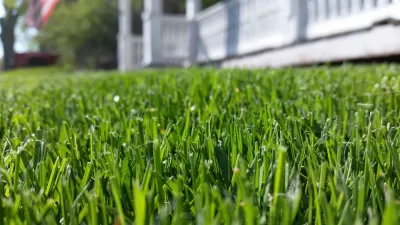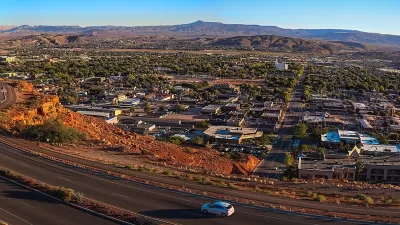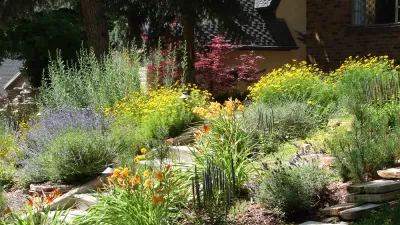Long held as a symbol of middle-class success and the American Dream, homogenous, monocultural lawns are quickly falling out of favor as people opt for more ecologically friendly gardens that conserve water and increase biodiversity.

Writing in the Washington Post, Dan Zak examines the American obsession with lawns and the growing anti-lawn movement gaining steam in an era of extreme water shortages.
American suburbia has long been defined by “Lawns: emerald green — no, alien green — and kept that way by maniacal vigilance and an elaborate system of pipes and potions, organic and otherwise, in defiance of ecology.” Zak positions awns as a container for our national anxieties, writing: “We’ve been sweeping our anxieties under these green comfort blankets for quite some time.”
In the early and middle parts of the twentieth century, “Lawns were a sign of taste, calm, power, privilege, order, discipline, especially in the aftermath of World War II.” More recently, that trend has reversed, as lawns “began to signal waste, disregard, disharmony, homogeneity, gentrification, zombie Boomerism.” While ornamental lawn grass is still the biggest crop in America, using 9 billion gallons of water a day, attitudes are shifting. “California’s main water utility is paying customers between $2 and $5 for each square foot of living turf that they remove. Last year Nevada outlawed certain types of lawn; rather, the state legislature prohibited the use of water from the dribbling Colorado River to feed certain types of “nonfunctional turf,” which in southern Nevada slurps up to 12 billion gallons of water every year (more than 10 percent of the state’s usage of the river).”
As landscaper Dave Marciniak points out, “Turf serves a purpose, he wrote. It’s soft and durable for recreation. It provides visual relief for the eye, and contrast for landscaping.” But other materials and plants can serve the same purpose, and more lawn devotees are realizing the potential of xeriscaping and other eco-friendly ways to replace lawns with sustainable, locally appropriate landscaping.
FULL STORY: There’s a water crisis. Why do we still have lawns?

Planetizen Federal Action Tracker
A weekly monitor of how Trump’s orders and actions are impacting planners and planning in America.

Congressman Proposes Bill to Rename DC Metro “Trump Train”
The Make Autorail Great Again Act would withhold federal funding to the system until the Washington Metropolitan Area Transit Authority (WMATA), rebrands as the Washington Metropolitan Authority for Greater Access (WMAGA).

The Simple Legislative Tool Transforming Vacant Downtowns
In California, Michigan and Georgia, an easy win is bringing dollars — and delight — back to city centers.

The States Losing Rural Delivery Rooms at an Alarming Pace
In some states, as few as 9% of rural hospitals still deliver babies. As a result, rising pre-term births, no adequate pre-term care and "harrowing" close calls are a growing reality.

The Small South Asian Republic Going all in on EVs
Thanks to one simple policy change less than five years ago, 65% of new cars in this Himalayan country are now electric.

DC Backpedals on Bike Lane Protection, Swaps Barriers for Paint
Citing aesthetic concerns, the city is removing the concrete barriers and flexposts that once separated Arizona Avenue cyclists from motor vehicles.
Urban Design for Planners 1: Software Tools
This six-course series explores essential urban design concepts using open source software and equips planners with the tools they need to participate fully in the urban design process.
Planning for Universal Design
Learn the tools for implementing Universal Design in planning regulations.
Smith Gee Studio
City of Charlotte
City of Camden Redevelopment Agency
City of Astoria
Transportation Research & Education Center (TREC) at Portland State University
US High Speed Rail Association
City of Camden Redevelopment Agency
Municipality of Princeton (NJ)





























